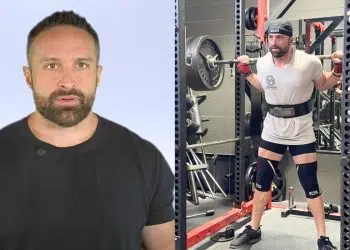The glute bridge is among the simplest bodyweight exercises in its most basic form. Although, you can certainly load it to increase the difficulty. There are also several variations that we’d recommend to really maximize the benefits. This movement works the hip muscles, core, glutes, and more.
Here’s a guide to the glute bridge…
In This Exercise:
- Target Muscle Group: Iliopsoas, pectineus, rectus abdominis
- Type: Strength
- Mechanics: Compound
- Equipment: Exercise mat (optional)
- Difficulty: Beginner
Muscles Worked
Glute bridges are the perfect bodyweight posterior chain exercise that targets a lot of muscles. Learn about their anatomy and function below.
Iliopsoas
When it comes to hip flexion, iliopsoas is the boss muscle because of its superior size, strength, and role as in the lower body. Iliopsoas is more than one muscle including a psoas major, minor and iliacus.
Pectineus
The pectineus is found on the anterior inner thigh of which it contributes to primarily adduction of the leg but also flexion, external and internal rotation, and posture.
Rectus Abdominis
We use the rectus abdominis or abdominal muscles to perform things like crunches and pretty much every exercise.
Level Up Your Fitness: Join our 💪 strong community in Fitness Volt Newsletter. Get daily inspiration, expert-backed workouts, nutrition tips, the latest in strength sports, and the support you need to reach your goals. Subscribe for free!
Obliques
More toward the lateral part of the trunk than the abdominals, the oblique muscles help us to twist from one side to the other.
Quadriceps and glutes
The quadriceps muscles on the thigh and the glutes or butt muscles perform their actions at the hip and knee. Quads perform hip flexion and knee extension while the gluteus maximus extends and externally rotates the thigh.
How To Do The Glute Bridge
- Lie on your back with your knees bent and feet flat on the floor as shown in the video example below Place your arms by your sides.
- Tighten your core, and lift your hips so that your body forms a straight line.
- Drop your hips back down and repeat.
Tips
- Do not hyperextend your lower back
- Keep your core tight throughout the entire movement
- Do not place your feet too close or too far from your body.
3 Variations of the Glute Bridge
The basic bodyweight glute bridge is a viable option for some people. However, for those who are more experienced with resistance training, it may not be challenging enough to elicit significant results.
Here are some excellent variations to ensure you progress with this movement.
Related: Glute Bridge: 5 Effective Variations For A Better Butt
Single-leg glute bridge
The single-leg glute bridge takes the basic bodyweight version and adds a level of increased difficulty. Although, you can certainly add weight to the single-leg variation. Not to mention, training one side at a time builds unilateral (affecting one side) strength and function, which engages stabilizer and core muscles to a greater extent.
Straight-leg bridge
Want a real bodyweight glute bridge challenge? Try the straight-leg bridge as shown below.
Barbell glute bridge/hip thrust
There’s no better exercise for building glute and hip muscles than the barbell hip thrust. That’s because you can load this movement with very heavy weight which we know is key to hypertrophy and strength. Plus, you can even do the single-leg variation to further improve your unilateral strength.
How To Incorporate The Glute Bridge Into Your Training Routine
How you incorporate the glute bridge depends on your goals. For example, the basic bodyweight variation is great for beginners and higher reps sets. Then, you can progress to the single-variation variation when the basic version becomes less challenging.
If you’re looking to really pack on the muscle mass, then you’ll need to load this movement of which the barbell is the best tool for this. Although, some machines are great as well. But it’s very important to challenge yourself and the great thing is that you can safely use a lot of weight with this movement.
We recommend 3-4 sets of 6-25 reps for most workout sessions of which you’ll vary the number of reps depending on your training strategy for each session.
Wrapping Up
The glute bridge and its variations are staples for building stronger hips and glutes. It’s a safe exercise that’s simple to execute and nearly anyone can do it safely and effectively.
Interested in measuring your progress? Check out our strength standards for Hip Thrust, Glute Bridge, Barbell Glute Bridge, and more.











